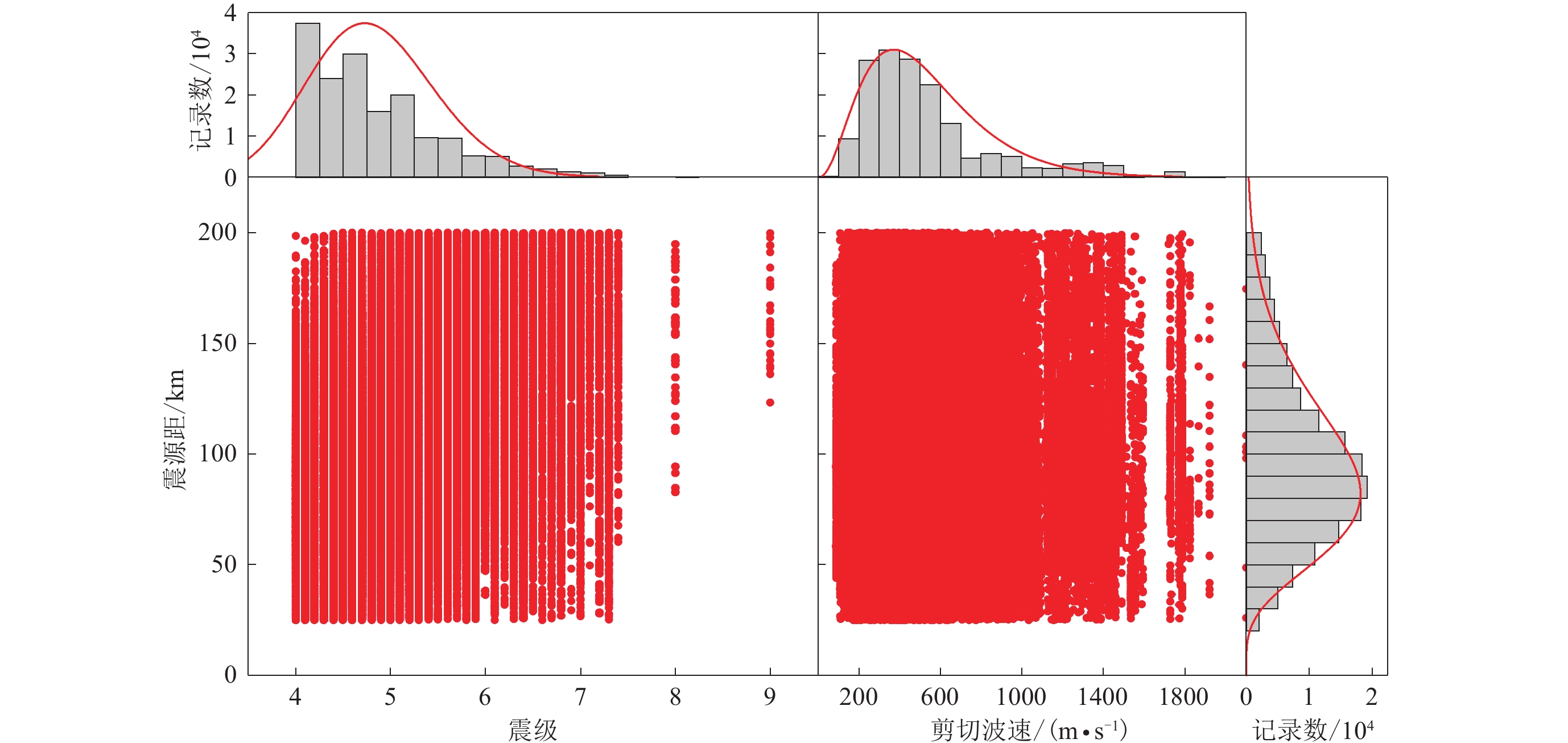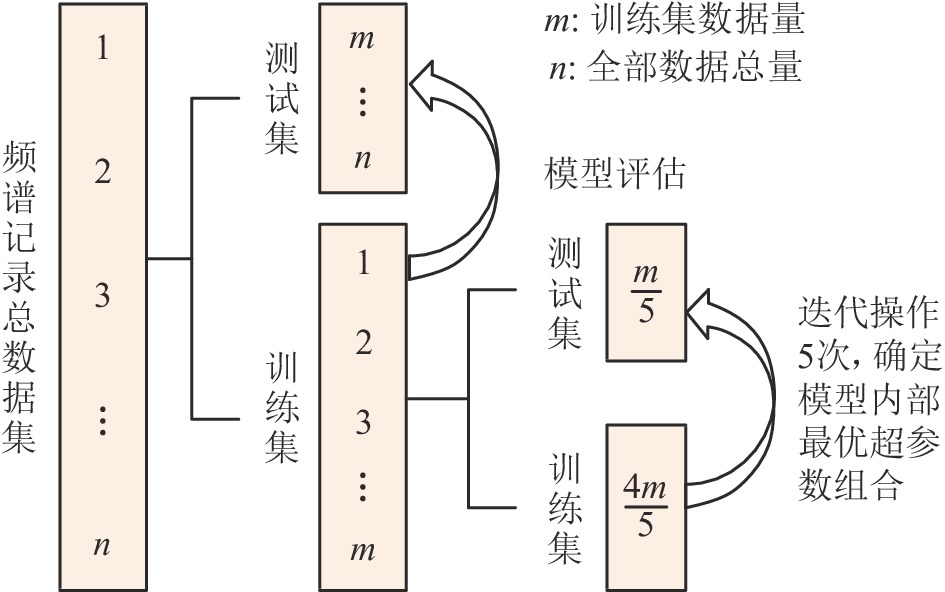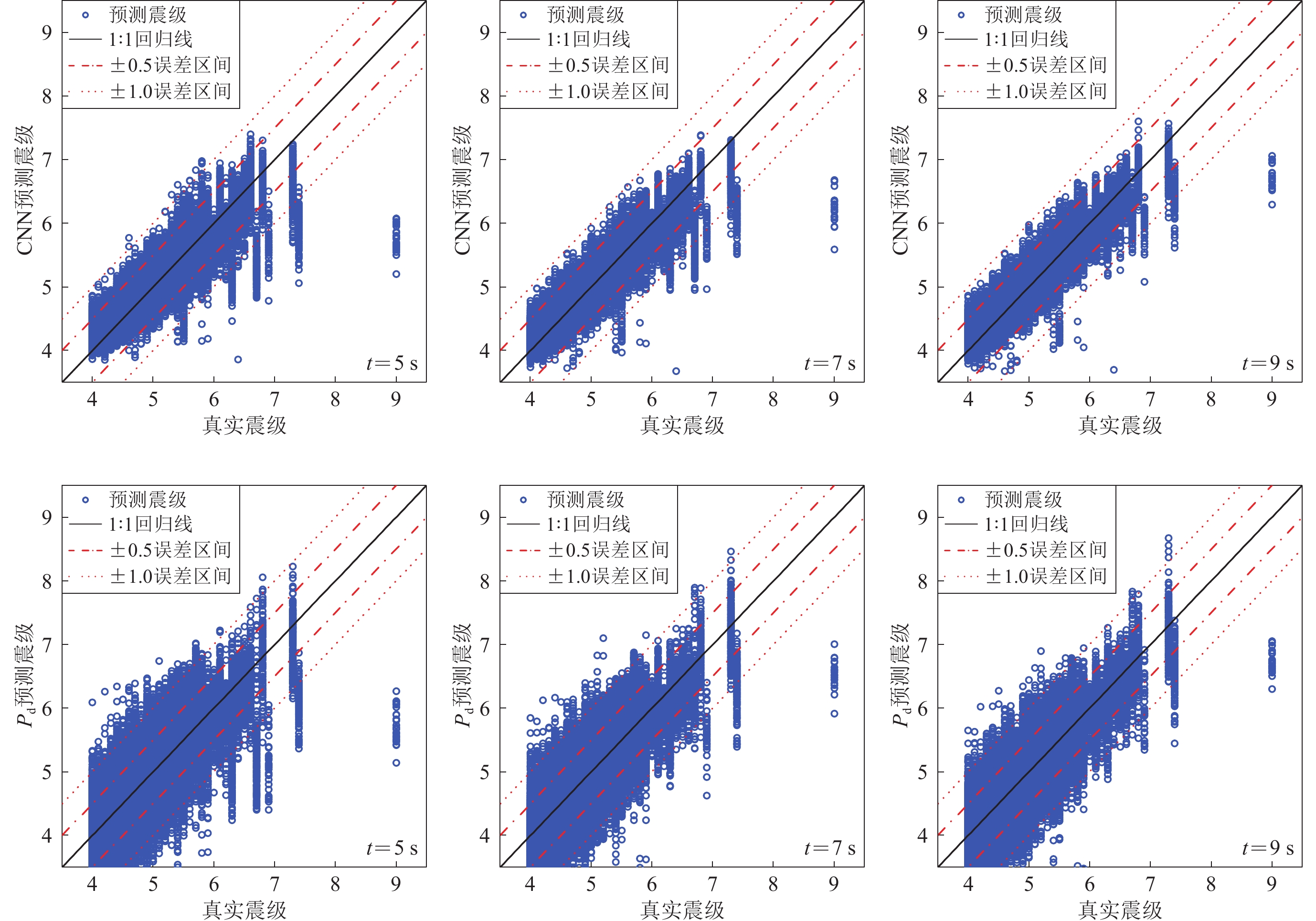A fast estimation method of earthquake magnitude based on convolutional neural networks
-
摘要: 地震发生后震级的快速准确估算是确保地震预警减灾效果的最重要部分,而基于经验参数的传统方法在准确性和时效性方面各自存在局限性。通过建立多全连接层卷积神经网络模型,选用日本KiK-net和K-NET台网1997年至2019年记录到的3 065次地震的16万4 547条初至波在3—9 s不同时段的频域数据、对应地震事件的震源信息(震中距和震源深度)以及场地信息(vS30)作为全数据集,对提出的模型进行训练并对估算效果予以评估。结果显示:当初至波截取时段为3 s时,模型震级预测的整体准确率为89.92%,并且随着初至波长度的增大,估算震级的准确率持续提高;当截取时段为9 s时,整体准确率达到96.08%。与传统Pd方法的预估结果相比,结果表明:基于本文提出的多全连接层卷积神经网络模型估算的震级精度有所改善,具有绝对误差标准差和均值更小、时效强等特性,实现了基于单台站记录的端到端震级持续快速估算,能更好地增强地震预警的减灾效果。Abstract: Earthquake early warning (EEW) is an effective approach to reduce human casualty and economic loss resulted from destructive earthquakes. Quick and accurate magnitude estimation after an earthquake is an important part of EEW, and the traditional approaches of magnitude estimation based on empirical parameters have their limits in accuracy and timeliness. This paper proposed a multi-fully connected convolutional neural network to quickly estimate the magnitude based on the information from a single station. The frequency-domain information from 3 065 earthquakes recorded by Japan’s KiK-net and K-NET networks between 1997 and 2019 (arriving waves corresponding to the selected data ranging from 3 s to 9 s), together with the corresponding information on hypocentral distance, focal depth, and site conditions (vS30) are used to train and validate the proposed model. The validation results demonstrate that the magnitude estimate accuracy is 89.92% even using as little as 3 s of arriving waves and the accuracy improves as longer duration of arriving waves is used. When 9 s of arriving waves are used, the accuracy increases to 96.08%. Comparison with the traditional Pd method suggests that the proposed approach in this study has smaller mean and standard deviation of the absolute estimation error, thus the proposed method has better accuracy and timeliness and would greatly enhance the disaster mitigation effects of the EEW systems.
-
-
表 1 场地条件分类(引自Zeynalov et al,2013)
Table 1 Site condition classification (after Zeynalov et al,2013)
场地分类 场地分类 vS30/(m·s−1) A 硬土 [ 600,+∞) B 中土 [ 200,600) C 软土 (0,200) 注:vS30代表地表下30 m土体的平均剪切波速。 表 2 神经网络(CNN)模型和Pd参数方法在不同时窗下的预测结果统计
Table 2 Prediction result statistics of neural network model (CNN) and Pd with different time windows
时窗长度/s 误差标准差 误差平均值 准确率 CNN Pd CNN Pd CNN Pd 4 0.234 0 0.329 1 0.224 4 0.419 8 92.46% 66.09% 5 0.218 0 0.305 9 0.222 8 0.396 7 93.32% 68.83% 6 0.197 8 0.282 9 0.199 3 0.376 6 94.91% 71.17% 7 0.185 2 0.267 5 0.194 7 0.361 7 95.41% 73.02% 8 0.173 9 0.259 1 0.189 7 0.351 5 95.78% 74.43% 9 0.164 6 0.254 4 0.191 3 0.343 1 96.08% 75.52% -
陈运泰. 2009. 地震预测:回顾与展望[J]. 中国科学:D辑,39(12):1633–1658. Chen Y T. 2009. Earthquake prediction:Retrospect and prospect[J]. Science in China:Series D,39(12):1633–1658 (in Chinese).
李山有. 2018. 走近地震预警[J]. 防灾博览,(2):14–23. Li S Y. 2018. Approaching the earthquake early warning[J]. Overview of Disaster Prevention,(2):14–23 (in Chinese).
马强. 2008. 地震预警技术研究及应用[D]. 哈尔滨: 中国地震局工程力学研究所: 96–102. Ma Q. 2008. Study and Application on Earthquake Early Warning[D]. Harbin: Institute of Engineering Mechanics, China Earthquake Administration: 96–102 (in Chinese).
王延伟,李小军,曹振中,兰景岩,刘娟. 2020. 基于KiK-net井下基岩强震动记录的持续地震预警震级估算方法[J]. 地震工程与工程振动,40(4):42–52. Wang Y W,Li X J,Cao Z Z,Lan J Y,Liu J. 2020. Continuous estimation magnitude for earthquake early warning based on KiK-net borehole bedrock strong motions[J]. Earthquake Engineering and Engineering Dynamics,40(4):42–52 (in Chinese).
于子叶,储日升,盛敏汉. 2018. 深度神经网络拾取地震P和S波到时[J]. 地球物理学报,61(12):4873–4886. doi: 10.6038/cjg2018L0725 Yu Z Y,Chu R S,Sheng M H. 2018. Pick onset time of P and S phase by deep neural network[J]. Chinese Journal of Geophysics,61(12):4873–4886 (in Chinese).
Allen R M,Kanamori H. 2003. The potential for earthquake early warning in southern California[J]. Science,300(5620):786–789. doi: 10.1126/science.1080912
Allen R M,Gasparini P,Kamigaichi O,Böse M. 2009. The status of earthquake early warning around the world:An introductory overview[J]. Seismol Res Lett,80(5):682–693. doi: 10.1785/gssrl.80.5.682
Asano K,Iwata T. 2012. Source model for strong ground motion generation in the frequency range 0.1−10 Hz during the 2011 Tohoku earthquake[J]. Earth Planets Space,64(12):1111–1123. doi: 10.5047/eps.2012.05.003
Dokht R M H,Kao H,Visser R,Smith B. 2019. Seismic event and phase detection using time-frequency representation and convolutional neural networks[J]. Seismol Res Lett,90(2A):481–490. doi: 10.1785/0220180308
Espinosa-Aranda J M,Cuellar A,Garcia A,Ibarrola G,Islas R,Maldonado S,Rodriguez F H. 2009. Evolution of the Mexican seismic alert system (SASMEX)[J]. Seismol Res Lett,80(5):694–706. doi: 10.1785/gssrl.80.5.694
Geller R J. 1997. Earthquake prediction:A critical review[J]. Geophys J Int,131(3):425–450. doi: 10.1111/j.1365-246X.1997.tb06588.x
Hinton G E,Salakhutdinov R R. 2006. Reducing the dimensionality of data with neural networks[J]. Science,313(5786):504–507. doi: 10.1126/science.1127647
Hoshiba M,Kamigaichi O,Saito M,Tsukada S,Hamada N. 2008. Earthquake early warning starts nationwide in Japan[J]. Eos Trans Am Geophys Union,89(8):73–74.
Lockman A B,Allen R M. 2005. Single-station earthquake characterization for early warning[J]. Bull Seismol Soc Am,95(6):2029–2039. doi: 10.1785/0120040241
Lomax A,Michelini A,Jozinović D. 2019. An investigation of rapid earthquake characterization using single‐station waveforms and a convolutional neural network[J]. Seismol Res Lett,90(2A):517–529. doi: 10.1785/0220180311
Melgar D,Crowell B W,Geng J H,Allen R M,Bock Y,Riquelme S,Hill E M,Protti M,Ganas A. 2015. Earthquake magnitude calculation without saturation from the scaling of peak ground displacement[J]. Geophys Res Lett,42(13):5197–5205. doi: 10.1002/2015GL064278
Minson S E,Meier M A,Baltay A S,Hanks T C,Cochran E S. 2018. The limits of earthquake early warning:Timeliness of ground motion estimates[J]. Sci Adv,4(3):eaaq0504. doi: 10.1126/sciadv.aaq0504
Mousavi S M,Beroza G C. 2020. A machine‐learning approach for earthquake magnitude estimation[J]. Geophys Res Lett,47(1):e2019GL085976.
National Research Institute for Earth Science and Disaster Resilience. 2020. Strong-motion seismograph networks (K-NET, KiK-net)[EB/OL]. [2020-10-21]. https://www.kyoshin.bosai.go.jp/kyoshin/data/index_en.html.
Peng C Y,Yang J S,Zheng Y,Zhu X Y,Xu Z Q,Chen Y. 2017. New τc regression relationship derived from all P wave time windows for rapid magnitude estimation[J]. Geophys Res Lett,44(4):1724–1731.
Saad O M,Hafez A G,Soliman M S. 2020. Deep learning approach for earthquake parameters classification in earthquake early warning system[J]. IEEE Geosci Remote Sens Lett,18(7):1293–1297.
Wang Y W,Li X J,Wang Z F,et al. 2021. Deep learning for P-wave arrival picking in earthquake early warning[J]. Earthq Eng Eng Vib,20(2):391–402. doi: 10.1007/s11803-021-2027-6
Wolfe C J. 2006. On the properties of predominant-period estimators for earthquake early warning[J]. Bull Seismol Soc Am,96(5):1961–1965. doi: 10.1785/0120060017
Wu Y M,Teng T. 2002. A virtual subnetwork approach to earthquake early warning[J]. Bull Seismol Soc Am,92(5):2008–2018. doi: 10.1785/0120010217
Wu Y M,Kanamori H. 2005. Rapid assessment of damage potential of earthquakes in Taiwan from the beginning of P waves[J]. Bull Seismol Soc Am,95(3):1181–1185. doi: 10.1785/0120040193
Wu Y M,Zhao L. 2006. Magnitude estimation using the first three seconds P‐wave amplitude in earthquake early warning[J]. Geophys Res Lett,33(16):L16312. doi: 10.1029/2006GL026871
Zeynalov L,Polukhov I,Gölalmış M. 2013. Comparison of Azerbaijan and other seismic codes[J]. Earthq Resist Eng Struct IX,132:205–217.
Zhu W Q,Beroza G C. 2019. PhaseNet:A deep-neural-network-based seismic arrival-time picking method[J]. Geophys J Int,216(1):261–273.
Zollo A,Lancieri M,Nielsen S. 2006. Earthquake magnitude estimation from peak amplitudes of very early seismic signals on strong motion records[J]. Geophys Res Lett,33(23):L23312. doi: 10.1029/2006GL027795





 下载:
下载:






